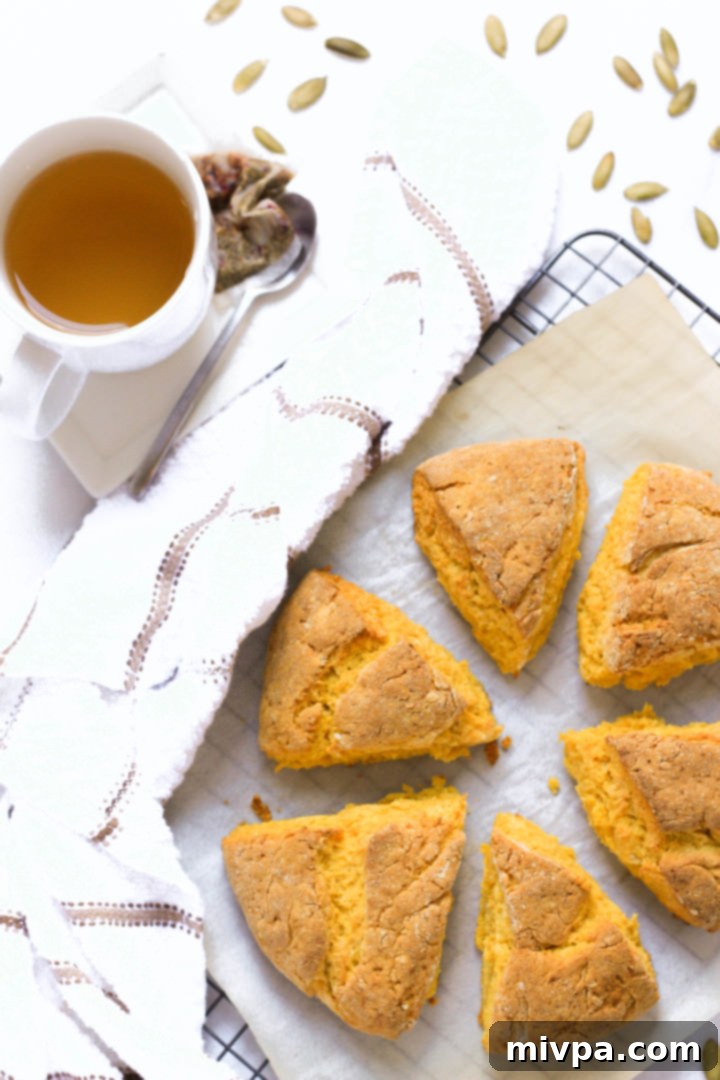Fluffy & Flavorful: Your Guide to Easy Gluten-Free Dairy-Free Pumpkin Scones in 30 Minutes!
Imagine the perfect scone: wonderfully moist, incredibly fluffy, and so tender it practically melts in your mouth. Now imagine that scone bursting with rich, earthy pumpkin flavor, incredibly simple to prepare, and ready to enjoy in just 30 minutes! These delightful gluten-free pumpkin scones are precisely that and more. Whether you’re looking for a comforting breakfast treat, a satisfying afternoon snack, or a light and lovely dessert, these scones fit the bill perfectly. And the best part? They taste so utterly delicious, you’ll never guess they’re completely dairy-free too! Prepare to be amazed by how easily you can bring this autumnal (or any-time-of-year!) bliss into your kitchen.
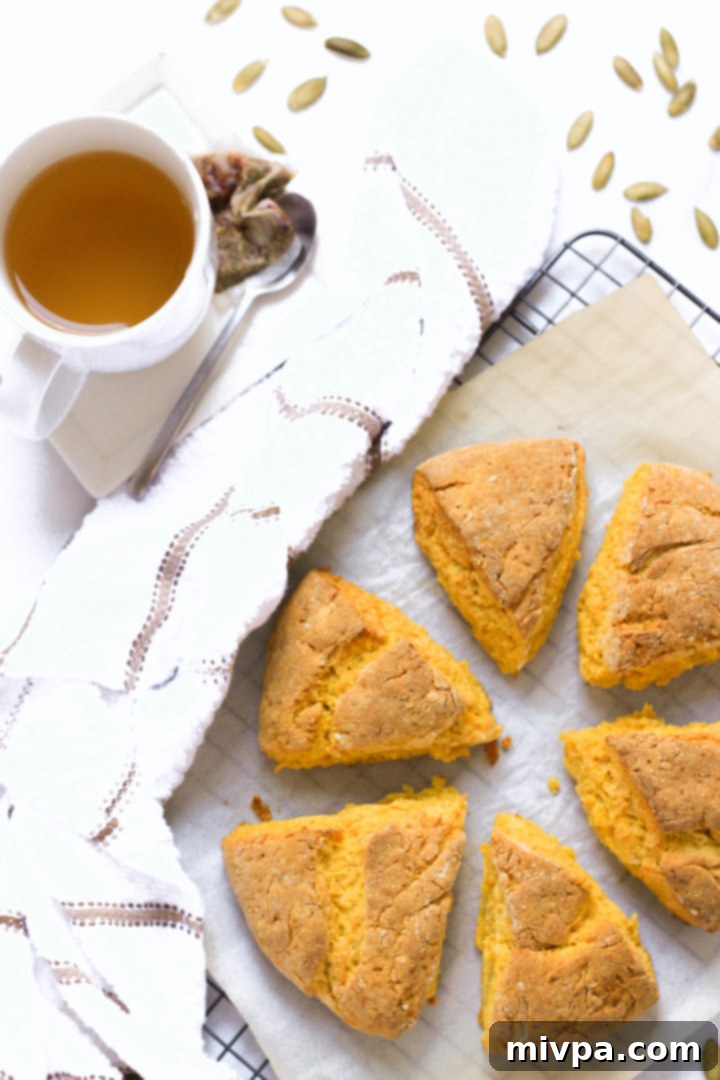
[feast_advanced_jump_to]
Recreating Cherished Memories with Every Bite
Food often holds the most powerful key to our memories, and for me, baking scones is a deeply personal journey rooted in nostalgia. When I first began to delve into the art of baking during my time in Argentina, one of the very first recipes I ever attempted was for scones. These weren’t just any scones; they were Juan’s mum’s homemade scones, a beloved family recipe that had been a staple for him and his brother since their childhood. The mere mention of scones would instantly transport Juan back to his formative years, evoking feelings of comfort, warmth, and the simple joys of home.
However, life took an unexpected turn when Juan was diagnosed with Celiac disease. This meant we had to transition to an exclusively gluten-free diet, a change that brought its own set of challenges, especially in baking. I honestly never thought that I’d be able to faithfully re-create the same kind of light, airy, and perfectly crumbly scones his mum used to make. Achieving the right texture with gluten-free flours is notoriously difficult. The main reason? Gluten, the protein naturally found in wheat, is what gives traditional baked goods their elasticity, structure, and chewiness. Without it, baked items often end up dense, heavy, or easily fall apart. It felt like an impossible task to capture that familiar magic in a gluten-free version.
Gluten-Free Pumpkin Scones: A Triumphant Success!
My persistence paid off in the most heartwarming way. The moment I pulled these gluten-free pumpkin scones, fragrant and golden-brown, from the oven, I knew they were special. But the real test came when Juan took his first bite. His eyes immediately lit up with an unmistakable spark of recognition and joy. He exclaimed that they reminded him so much of his mum’s scones – a truly priceless compliment that brought a wave of relief and happiness over me. For me, that affirmation meant these pumpkin scones were not just a success, but a monumental triumph in our gluten-free baking journey!
This recipe not only delivers on flavor but also perfectly replicates the texture that is often elusive in gluten-free baking. It’s a testament to how careful ingredient selection and a thoughtful approach can yield results that are virtually indistinguishable from their traditional counterparts. This success means we can continue to create new, comforting memories together, without any dietary compromises.
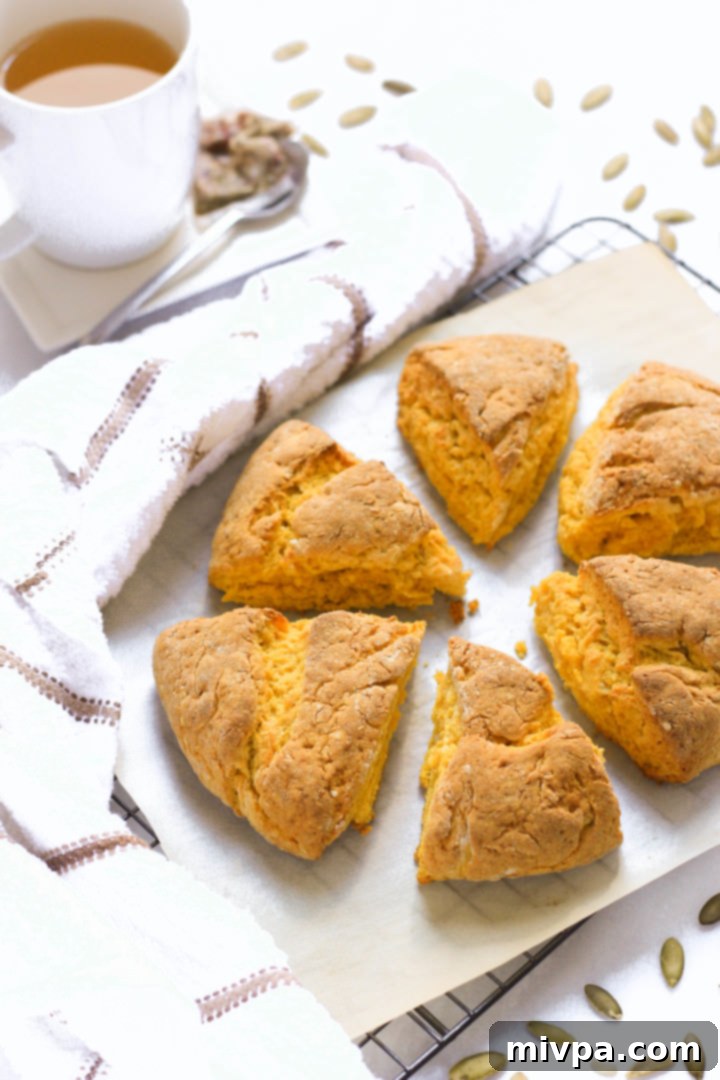
Why This Gluten-Free Pumpkin Scone Recipe is a Must-Try:
- Simple, Accessible Ingredients: You won’t need to hunt for exotic items at a specialty store for this recipe. All the ingredients required for these gluten-free pumpkin scones are readily available at your local grocery store. We believe that delicious, healthy baking should be accessible to everyone, and this recipe proves it – nothing fancy or hard-to-find required!
- Remarkably Easy to Make: Even if you’re a beginner baker, you’ll find this recipe incredibly straightforward. Preparing the scone dough is simply a matter of combining wet and dry ingredients, a quick mix, then gently shaping the dough into triangles and baking. There are no complicated techniques or extensive steps involved, making it perfect for a busy morning or an impromptu baking session. Plus, you have the flexibility to use either fresh homemade pumpkin puree or convenient canned pumpkin puree, ensuring you can enjoy these delightful scones all year round, not just during the peak pumpkin season.
- Unbelievable Texture: This is where these scones truly shine! They boast a light, airy, and wonderfully fluffy interior with a delicately tender crumb that defies typical gluten-free expectations. Unlike many gluten-free baked goods that can often be on the heavier and denser side, these pumpkin scones are remarkably light and delightful. Seriously, you and your guests will never be able to tell that these are completely gluten-free!
- Completely Gluten-Free & Dairy-Free: Beyond their incredible taste and texture, the absolute best part is that these comforting pumpkin scones are 100% gluten-free and dairy-free. This makes them a perfect option for those with Celiac disease, gluten sensitivities, lactose intolerance, or anyone following a plant-based diet. Now, everyone can enjoy a classic scone without any dietary concerns or compromises on flavor and enjoyment!
Essential Ingredients: Notes and Smart Substitutions
Here’s a detailed overview of the key ingredients required for these fantastic gluten-free pumpkin scones, along with helpful notes and potential substitutions to ensure your baking success.
(For exact measurements, please scroll down to the full, printable recipe card located at the bottom of this post.)
- Gluten-Free All-Purpose Flour Blend: The quality of your flour blend is paramount for achieving the perfect scone texture. It’s crucial to use a good quality gluten-free all-purpose flour blend that is predominantly made with lighter flours and starches. Look for blends that list ingredients such as rice flour (white or brown), corn starch, potato starch, or tapioca starch. These light components are key to creating a scone that is delicate and fluffy. I strongly advise against using blends that contain heavier flours like garbanzo bean flour (chickpea flour), almond flour, or coconut flour as a primary ingredient, as these tend to absorb more liquid and will result in a significantly denser, heavier, and often drier final texture.
- Xanthan Gum: In gluten-free baking, xanthan gum acts as a vital substitute for gluten. It functions as a binding agent, providing structure and elasticity to the dough that gluten would normally offer. This prevents your baked goods from becoming crumbly or falling apart. If your chosen gluten-free flour blend already lists xanthan gum (or a similar binder like guar gum) in its ingredients, you can confidently omit adding it separately. Always check your blend’s label!
- Sugar: For sweetness, I opted for classic white granulated sugar, which yields a clean, sweet flavor profile. However, you have several excellent alternatives depending on your preference. You can use cane sugar, light brown sugar for a subtle molasses note, dark brown sugar for a richer, more pronounced caramel-like flavor, or coconut sugar for a less refined option with a slight caramel taste. For those managing blood sugar levels, I highly recommend granulated monk fruit sweetener. This is a fantastic 1:1 sugar substitute that has a zero glycemic index, meaning it won’t spike your blood sugar.
- Baking Powder: As the sole leavening agent in this recipe, baking powder is absolutely essential for the scones to rise beautifully and achieve their characteristic light and airy texture. Do not skip or reduce this ingredient. For those with Celiac disease or gluten intolerance, it’s crucial to use certified gluten-free baking powder to avoid any hidden gluten contamination.
- Butter (Dairy-Free): To ensure these scones remain entirely dairy-free, I used a high-quality dairy-free butter. This contributes richness and helps create that desirable tender crumb. If you don’t have dairy-free butter, coconut oil can be used as an alternative, though the flavor profile might shift slightly. Importantly, regardless of whether you use dairy-free or regular butter (if you’re not lactose intolerant), make sure your butter is extremely cold, ideally frozen. This cold temperature is vital because when the cold butter pieces melt in the hot oven, they release steam, which creates pockets in the dough, resulting in a wonderfully flaky and tender scone. Grating the frozen butter makes it easier to incorporate into the dry ingredients evenly.
- Almond Milk: I prefer using an unsweetened version of my homemade almond milk for a neutral flavor. However, the beauty of this recipe is its adaptability. You can easily substitute it with other non-dairy milks such as cashew milk, oat milk, rice milk, tigernut milk, or even coconut milk for a richer taste. Ensure any alternative milk is also unsweetened to control the overall sweetness of the scones. If you don’t have lactose intolerance, regular dairy milk works perfectly fine too.
- Pumpkin Puree: While convenient canned pumpkin puree can certainly be used, I highly recommend taking the extra step to make your own homemade pumpkin puree. In my opinion, homemade puree offers a richer, more authentic flavor, is significantly cheaper than store-bought options, and is healthier because it’s free from the additives and preservatives often found in canned versions. If pumpkin isn’t your favorite or isn’t available, you can substitute it with equal quantities of sweet potato puree, butternut squash puree, or even unsweetened apple puree for a different autumnal twist.
- Egg Substitute: For those with an egg allergy or if you simply wish to keep this recipe entirely egg-free and vegan, suitable alternatives include acquafaba (the liquid from canned chickpeas) or a commercial egg replacer powder mixed according to package instructions. These substitutes help bind the dough and contribute to moisture without compromising the final texture.
- Yogurt (Dairy-Free): The addition of dairy-free yogurt is key to enhancing the scone’s tenderness and moisture while keeping the recipe dairy-free. The slight acidity in yogurt also reacts with the baking powder, aiding in the rise and contributing to a lighter crumb. If you are not lactose intolerant, feel free to use regular plain yogurt instead; full-fat Greek yogurt will provide an even richer texture.

How to Make Perfect Gluten-Free Pumpkin Scones (Step by Step Guide):
Follow these simple steps to create delicious, flaky, and tender pumpkin scones that are both gluten-free and dairy-free!
1. Preheat Your Oven and Prepare Your Baking Sheet
Begin by preheating your oven to a hot 425°F (220°C). This high temperature is crucial for helping the scones rise quickly and develop a beautiful golden crust. Line a large baking sheet or cookie sheet with a piece of parchment paper. Parchment paper prevents sticking and makes cleanup a breeze.
2. Whisk Together the Dry Ingredients
In a spacious medium bowl, combine the gluten-free all-purpose flour blend, xanthan gum (if your flour blend doesn’t already contain it), baking powder, and a pinch of salt. Use a whisk to thoroughly mix these ingredients together, ensuring they are well-combined and evenly distributed. This step helps to aerate the flour and ensures consistent leavening throughout the dough.
3. Incorporate the Cold Butter
Using a cheese grater, grate the very cold (or frozen) dairy-free butter directly into the bowl of dry ingredients. This method creates small, even pieces of butter, which are essential for a flaky texture. Once grated, use your fingertips to gently mix the butter into the flour mixture until it resembles coarse crumbs, with no large chunks of butter remaining. Alternatively, you can use a pastry cutter to cut the butter into the flour until it forms small, pea-sized pieces.
4. Prepare the Wet Ingredients
In a separate large mixing bowl, combine the pumpkin puree, egg (or egg substitute), almond milk (or other non-dairy milk), and dairy-free yogurt. Whisk these wet ingredients together until they are fully combined and smooth. This ensures an even distribution of flavor and moisture throughout your scones.
5. Gently Combine Wet and Dry Ingredients to Form the Dough
Gradually add the dry ingredients mixture into the wet ingredients bowl, stirring slowly with a spatula or wooden spoon. Mix just until a homogeneous and soft dough forms. Be careful not to overmix, as overworking gluten-free dough can lead to a tougher texture. A few dry streaks are perfectly fine; the goal is just to bring everything together.
6. Shape the Dough and Cut into Triangles
Carefully transfer the pumpkin scone dough onto a lightly floured surface. Make sure you’re using gluten-free flour for dusting to avoid any contamination. Gently use your hands to pat and form the dough into a round disc, approximately 2 inches thick. Using a sharp knife or a bench scraper, cut the disc into 6 equal triangles. Arrange these triangles on your prepared baking sheet, ensuring that each scone has ample space around it. Remember, the dough will expand slightly as it bakes, so give them room to grow!
7. Bake Until Golden Brown and Cooked Through
Place the baking sheet with the scone dough into the preheated oven. Bake for approximately 15 minutes, or until the edges of the scones turn a beautiful golden brown and a wooden tooth pick inserted into the center of a scone comes out clean. This indicates they are fully cooked. Once baked, remove the scones from the oven and transfer them to a wire rack to cool slightly before serving.
8. Serve Warm and Savor Every Bite
These tender gluten-free pumpkin scones are best enjoyed warm. Serve them as is for a simple treat, or elevate them with a dollop of whipped dairy-free cream, a drizzle of maple syrup, or your favorite jam. They pair wonderfully with a hot cup of coffee, tea, or even a glass of cold dairy-free milk!
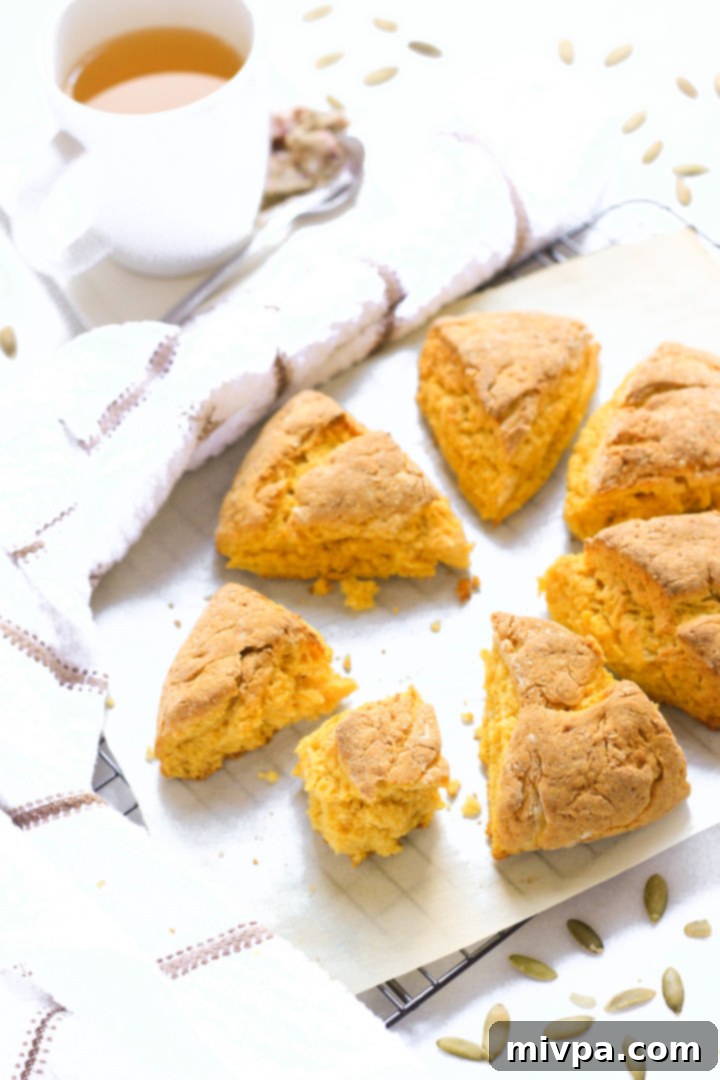
Frequently Asked Questions About These Gluten-Free Pumpkin Scones:
To maintain their freshness and delicious texture, ensure these gluten-free pumpkin scones are fully cooled to room temperature before storing. Once cool, wrap them individually in plastic wrap or aluminum foil, then place them in an airtight container. They will stay fresh in the refrigerator for up to 5 days. For best results, gently warm them in the microwave or oven before serving to revive their tenderness.
Absolutely! These pumpkin scones freeze beautifully, making them perfect for meal prepping or having a quick treat on hand. Simply allow them to cool completely, then place them in a single layer in a freezer-safe container or a heavy-duty ziplock bag, ensuring as much air is removed as possible to prevent freezer burn. They can be frozen for up to 3 months. When you’re ready to enjoy them, thaw them overnight in the refrigerator, then warm them up for a few minutes in a 350°F (175°C) oven or briefly in the microwave for that freshly baked taste.
Yes, you certainly can! While pumpkin puree adds a delightful flavor and moistness, you can easily adapt this recipe. If you prefer to make these scones without using pumpkin puree, simply swap it out with equal quantities of another smooth, cooked vegetable or fruit puree. Great alternatives include sweet potato puree, butternut squash puree, or even unsweetened apple puree. Each will lend a slightly different, but equally delicious, flavor profile to your scones.
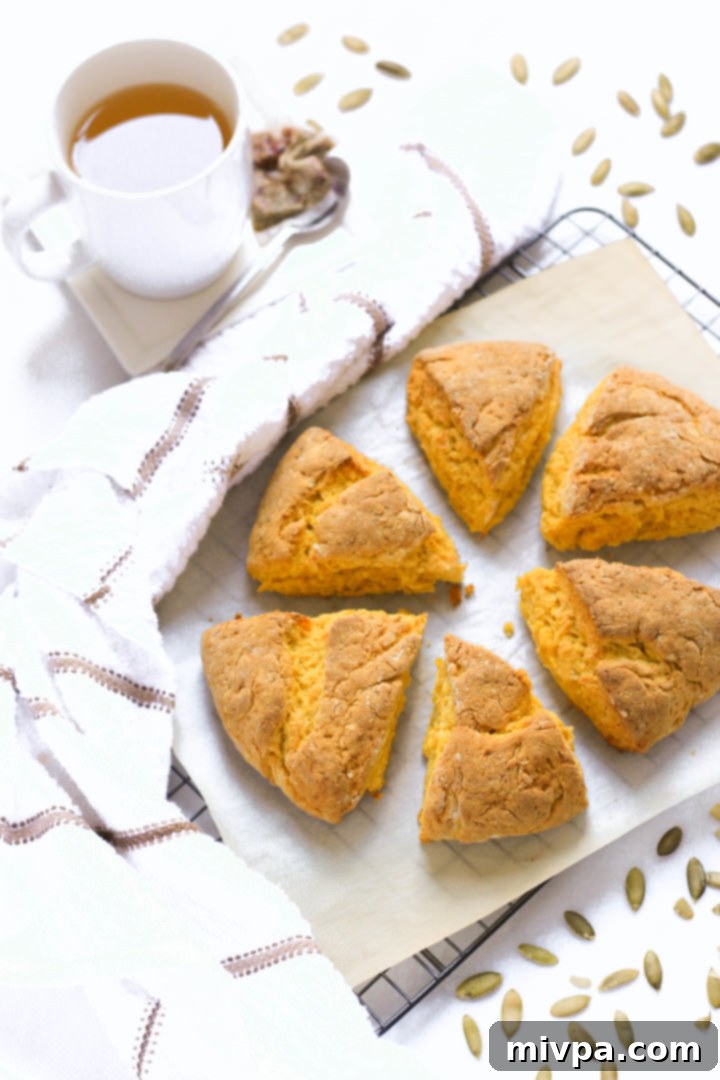
Other Delicious Pumpkin Recipes You’ll Love:
- Homemade Pumpkin Puree (Gluten-Free, Vegan)
- Crustless Pumpkin Pie (Gluten-Free, Dairy-Free)
- Easy Pumpkin Muffins (Gluten-Free, Vegan)
- Easy Pumpkin Bread (Gluten-Free, Vegan)
- Super Moist Gluten-Free Pumpkin Bread
- Pumpkin Cheesecake (Gluten-Free, Vegan)
- Pumpkin Waffles (Gluten-Free)
- Savory Pumpkin Soup (Gluten-Free, Vegan)
- Pumpkin Thyme Risotto (Gluten-Free)
- Pumpkin Gnocchi with Rosemary Brown Butter (Gluten-Free)
Other Irresistible Gluten-Free Sweet Treats to Indulge In:
- Gluten-Free Pumpkin Banana Muffins (Dairy-Free)
- 126 Gluten-Free Desserts and Sweet Treats for Labor Day
- Mini Pumpkin Cheesecakes (Gluten-Free, Dairy-Free Option)
- Gluten-Free Pecan Pie Bars (Dairy-Free)
P.S. If you try this recipe, I’d love for you to leave a star rating below, and/or a review in the comment section further down the page. I always appreciate your feedback. Be sure to check out my entire Recipe Index for all the recipes on the blog. You can also follow me on Pinterest, Facebook or Instagram! Sign up for my Email List to get fresh recipes in your inbox each week!
Print

Gluten-free Pumpkin Scones
5 Stars 4 Stars 3 Stars 2 Stars 1 Star
4.8 from 8 reviews
Author: felicia | Dish by Dish
Total Time: 30 minutes
Yield: 6 large scones
Diet: Gluten Free, Dairy Free
Description
Moist, fluffy, and tender, these utterly delicious gluten-free pumpkin scones are crazy simple to make, oozing with delightful pumpkin flavor, and incredibly fast, ready in just 30 minutes! These versatile scones make the perfect warm breakfast, a satisfying afternoon snack, or a light and charming dessert. They honestly taste so good you’ll never know they’re dairy-free too, making them a perfect treat for everyone!
Ingredients
Units
Scale
- 1 1/2 cups gluten-free all-purpose flour blend (see notes for important details)
- 1/4 teaspoon xanthan gum (omit if your gluten-free flour blend already has it)
- 1/2 cup granulated sugar (or preferred sweetener)
- 3 teaspoons baking powder (ensure it’s certified gluten-free)
- 1/2 teaspoon salt
- 6 tablespoons very cold, grated unsalted dairy-free butter (frozen is ideal)
- 1/2 cup pumpkin puree (homemade or canned)
- 1 large egg (or egg substitute for egg-free)
- 1 tablespoon unsweetened almond milk (or other non-dairy milk)
- 1 tablespoon plain dairy-free yogurt (for added moisture and tenderness)
Instructions
- Preheat Oven and Line Baking Sheet: Preheat your oven to a precise 425°F (220°C). This ensures a quick rise and golden crust. Prepare a large baking sheet by lining it with parchment paper to prevent sticking and aid in easy cleanup.
- Whisk Dry Ingredients: In a medium-sized mixing bowl, thoroughly whisk together the gluten-free all-purpose flour blend, xanthan gum (if not already in your blend), baking powder, and salt. Whisking ensures these ingredients are evenly distributed, which is vital for the scone’s texture and rise.
- Grate and Incorporate Cold Butter: Using a cheese grater, grate the frozen dairy-free butter directly into the bowl of dry ingredients. Mix gently with your fingertips or a pastry cutter until the butter is evenly distributed and no large chunks remain. The mixture should resemble coarse crumbs.
- Combine Wet Ingredients: In a separate large mixing bowl, combine the pumpkin puree, egg (or egg substitute), almond milk, and dairy-free yogurt. Whisk these ingredients until they are well combined and smooth, ensuring a consistent mixture for the dough.
- Form the Scone Dough: Slowly add the dry ingredients mixture into the wet ingredients. Stir with a spatula or wooden spoon until a soft, homogeneous scone dough just forms. It’s crucial not to over-stir, as this can make gluten-free baked goods tough.
- Shape and Cut the Dough: Transfer the pumpkin scone dough onto a surface lightly dusted with gluten-free flour. Gently use your hands to pat the dough into a round disc, about 2 inches thick. With a sharp knife, cut the dough into 6 equal triangles. Place these triangles on the prepared baking sheet, ensuring each scone has enough space to expand during baking.
- Bake Until Golden: Place the baking sheet into the preheated oven. Bake for approximately 15 minutes, or until the edges of the scones turn a lovely golden brown and a toothpick inserted into the center comes out clean. This indicates they are perfectly baked through.
- Serve and Enjoy: Allow the pumpkin scones to cool on a wire rack for a few minutes before serving. They are delightful warm, either plain or enhanced with a dollop of whipped dairy-free cream, a drizzle of maple syrup, or your favorite jam for an extra special treat!
Notes
Gluten-Free All-Purpose Flour Blend: The type of gluten-free flour blend you choose significantly impacts the texture of your scones. For a light, fluffy, and tender result, it is essential to use a good quality gluten-free all-purpose flour blend that is primarily composed of light flours and starches. Look for blends containing ingredients like white rice flour, brown rice flour, corn starch, potato starch, or tapioca starch. These flours contribute to a delicate crumb. I strongly advise against using heavier, more absorbent flours such as garbanzo bean (chickpea) flour, almond flour, or coconut flour as your main flour in this recipe, as they can result in a much denser, drier, and heavier scone that doesn’t rise as well.
Xanthan Gum: Xanthan gum is a crucial ingredient in many gluten-free baking recipes, including these scones. It acts as a binder and thickener, essentially replacing the elasticity and structure that gluten provides. This helps prevent your scones from becoming crumbly and ensures they hold their shape with a pleasant texture. If your specific gluten-free flour blend already lists xanthan gum (or guar gum) in its ingredients, you can confidently omit the additional 1/4 teaspoon specified in this recipe. Always check your flour blend’s packaging first!
Sugar: I used standard white granulated sugar for a classic sweetness. However, feel free to customize the sweetness and flavor profile to your liking. You can substitute with cane sugar, light brown sugar for a hint of molasses, dark brown sugar for a richer, deeper caramel note, or coconut sugar for a less refined option with a subtle caramel undertone. If you are diabetic, insulin resistant, or simply looking to reduce sugar intake, I highly recommend using granulated monk fruit sweetener, which is a 1:1 sugar substitute with a zero glycemic index that will not raise your blood sugar levels.
Baking Powder: This is the sole leavening agent responsible for giving these scones their beautiful lift and light, fluffy texture. It reacts with the acidic ingredients (like yogurt and pumpkin) to create carbon dioxide bubbles, making the dough rise. Therefore, do not skip or reduce the amount of baking powder. For individuals with Celiac disease or gluten intolerance, it’s essential to use certified gluten-free baking powder to ensure no hidden gluten is present.
Butter (Dairy-Free): To keep this recipe entirely dairy-free, I’ve specified dairy-free butter. High-quality dairy-free butters perform very similarly to their dairy counterparts in baking. As an alternative, you can also use solid coconut oil. The critical tip here is that the butter (or coconut oil) must be extremely cold, ideally frozen, before you grate it into the dry ingredients. This is because tiny, cold pieces of fat will melt slowly in the oven, creating pockets of steam that result in a wonderfully flaky and tender interior. Warm or softened butter will not achieve the same flaky results.
Almond Milk: I typically use an unsweetened version of my homemade almond milk for a neutral flavor base. However, this recipe is quite flexible! You can easily swap almond milk for other unsweetened non-dairy milks such as cashew milk, oat milk, rice milk, tigernut milk, or even coconut milk (for a slightly richer flavor). Ensure that any milk alternative you choose is unsweetened to control the overall sugar content of your scones. If you don’t have lactose intolerance, regular dairy milk can be used in the same quantity.
Pumpkin Puree: While using convenient canned pumpkin is perfectly acceptable and will yield delicious results, I genuinely suggest making your own homemade pumpkin puree. In my experience, homemade puree boasts a superior, fresher flavor, is often more cost-effective than store-bought options, and is a healthier choice as it’s free from any additives or preservatives that might be found in canned varieties. If pumpkin is not readily available or you prefer a different flavor, you can substitute the pumpkin puree with equal quantities of sweet potato puree, butternut squash puree, or even unsweetened apple puree for a delightful variation.
Egg Substitute: To accommodate egg allergies or to keep this recipe entirely vegan, you can use an appropriate egg substitute. Excellent options include aquafaba (the viscous liquid from canned chickpeas – approximately 3 tablespoons per egg) or a commercial egg replacer powder, prepared according to the package directions. These alternatives will help bind the ingredients and contribute to the moistness of the scones.
Yogurt (Dairy-Free): The inclusion of dairy-free yogurt is a fantastic way to add extra moisture and tenderness to these scones, ensuring they remain dairy-free. The slight acidity in the yogurt also plays a role in activating the baking powder, contributing to a better rise and a more tender crumb. If you don’t have lactose intolerance, you can easily substitute with regular plain yogurt (full-fat Greek yogurt will add a wonderful richness) without altering the other measurements.
Barely adapted from: Laura Fuentes
- Prep Time: 15 mins
- Cook Time: 15 mins
- Category: Desserts, Breakfast, Snack
- Method: Baking
- Cuisine: American
